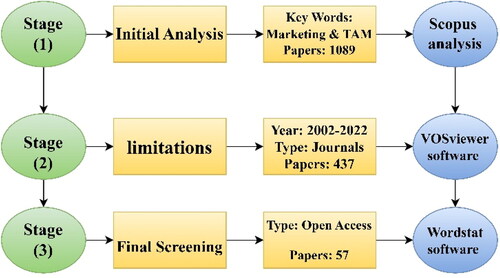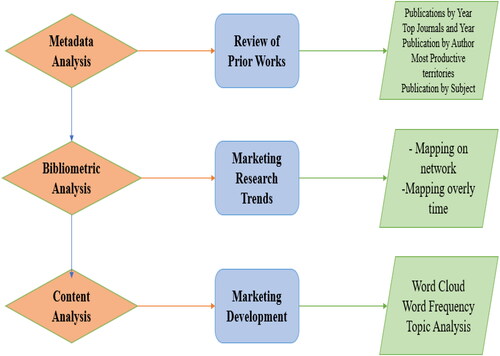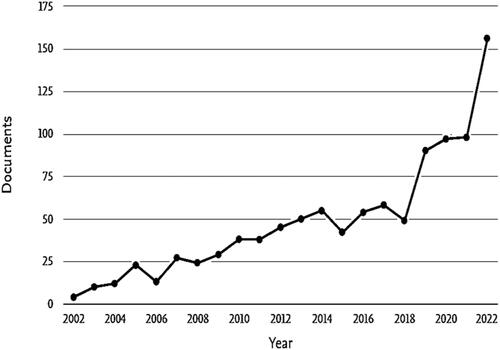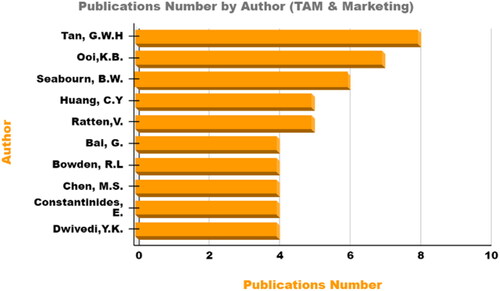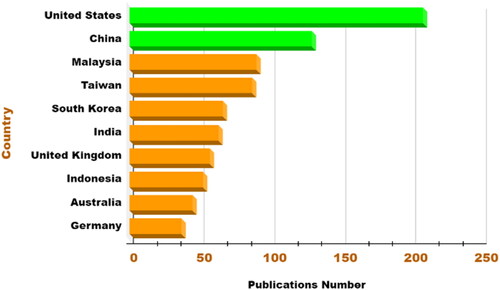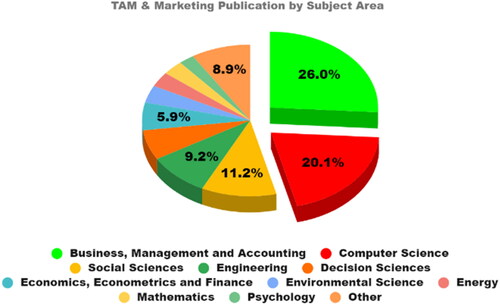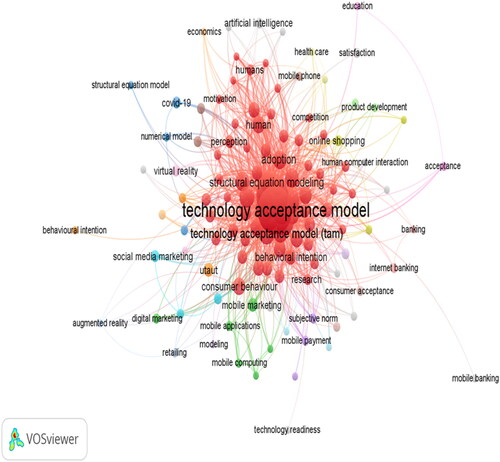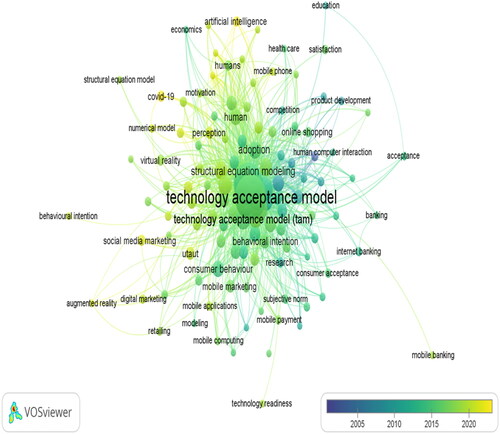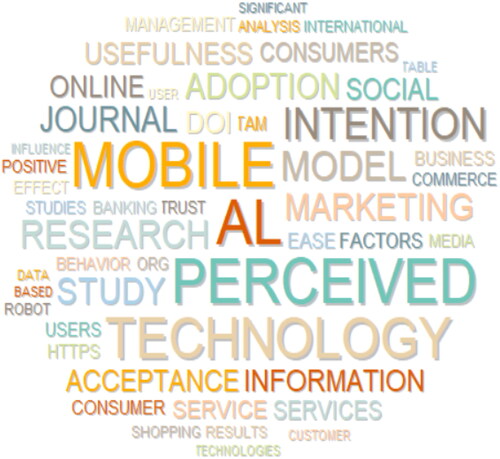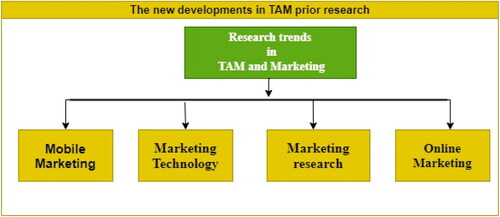Abstract
The technology acceptance model (TAM) is a widely accepted theoretical framework that explains how users accept and use technology. TAM has been applied in various marketing contexts to explain consumer behavior toward new technological products and services. By understanding how consumers perceive their products’ usefulness and ease of use, marketers can design effective marketing strategies that maximize consumer adoption and usage rates. This paper provides a comprehensive review of using TAM in marketing development. First, a metadata analysis was conducted by adopting 1089 papers from the Scopus database to review previous works in TAM and marketing. Second, a descriptive bibliometric analysis was performed using 437 published works and a VOS viewer to determine the recent development in using TAM in marketing. Third, content analysis of 57 papers using Wordstat was conducted to indicate the latest trends in marketing. Results reveal that marketing research using TAM is on an upward curve with limitations in implementing recent technologies. Sustainability Switzerland, Developments in Marketing Science, and International Journal of Bank Marketing were the top journals, Tan, G.W.H and Dr. Ooi Keng-Boon were the leading authors, business and management, computer science and social science were the principal areas of research, and USA, China, and Malaysia were the top countries. Results of bibliometric analysis reveal that mobile, technology, market research, and online marketing were the top trends in marketing. These results indicate the increasing importance of marketing trends and the TAM model used in today’s market and management.
IMPACT STATEMENT
Our paper offers a fascinating glimpse into the world of marketing research through the lens of the Technology Acceptance Model (TAM). In simple terms, TAM helps explain why people embrace new technology. By applying this framework to marketing, we unveil key insights into consumer behavior towards modern products and services. From smartphones to online shopping, TAM sheds light on why we adopt and use these innovations. Our findings reveal exciting trends in marketing, showing how businesses can harness TAM to create effective strategies that resonate with consumers. Whether you’re a tech enthusiast or a curious consumer, our paper provides valuable insights into the evolving landscape of marketing and technology adoption.
1. Introduction
The rapid advancement of technology, which is now affecting all aspects of existence somehow, has altered the pattern of human life, including businesses and marketing (Garad et al., Citation2021). The traditional manner has given way to digital activity. The field of management and economics, or more specifically, business, is inextricably linked to digital technology moving management operations in the business sector that were previously carried out traditionally (Ahn et al., Citation2004). The integration of technologies such as Artificial Intelligence (AI), Virtual Reality (VR), and Augmented Reality (AR) has reshaped marketing strategies across industries. For instance, AI-driven personalized recommendations have become a staple of online shopping experiences, enhancing customer engagement and satisfaction (Cao, Citation2021). VR and AR have revolutionized how customers interact with products before making purchasing decisions, providing immersive and interactive experiences (Dethe & Joy, Citation2023).
According to recent market research data, global spending on AI in marketing is projected to reach $17.3 billion by 2025, reflecting the urgency for businesses to harness AI-driven insights for targeted campaigns (Statista, Citation2020). Furthermore, the proliferation of VR and AR applications is expected to create a market worth $20.9 billion by 2025, with sectors ranging from retail to real estate leveraging these technologies to engage customers in novel ways (Dincelli & Yayla, Citation2022).
Several theoretical models have been presented over the last three decades to analyze and explain acceptance and behaviors related to marketing studies (Alhassan et al., Citation2020; Barakat & El Sheikh, Citation2010). Robust measurements of how well a technology ‘fits’ with user tasks have been created, and these technology-fit instruments have been validated. The technology acceptance model (TAM), first introduced in 1989, is the most well-known (Bujanov & Maier-Speredelozzi, Citation2021). It has been implemented and practically tested in applied science during this time. The TAM is also one of the most often used research models for predicting information system and technology use and a person’s intention to conduct a specific activity (Cheng et al., Citation2006). Initially, the TAM was created from the social psychological theories of reasonable action (TRA) and planned behavior (TPB). These three models focus on a person’s intention to perform a behavior, but their conceptions differ (Amaro et al., Citation2017).
After becoming a global interconnection network for information sharing and delivery, the Internet has become a powerful marketing platform for domestic and international transactions. People may have known the word ‘Internet’ for several years (Hofacker et al., Citation2020). The Internet comprises all devices connected by the Internet Protocol, developed by computer software. According to Rowley (Rowley, Citation1996), the Internet began as an academic network. However, since its popularity in business has grown, the Internet is now available to local universities, enterprises, and tourism marketers worldwide. IBM defined e-commerce as ‘business to vendors, customers, employees, and suppliers via Intranet, Extranets, and Internet E-Commerce’, with the Internet as the leading platform (Alkhowaiter, Citation2023).
As a result, countries seeking to enhance their economies through marketing must accept the Internet and be prepared for its benefits and drawbacks (Al-Ansi et al., Citation2019). Meanwhile, various elements influence the success of marketing on social platforms. In this regard, trust and customer engagement may control users’ willingness to engage in online transactions (Adomavicius et al., Citation2013). The Technology Acceptance Model (TAM) helps to understand what factors influence user acceptance of marketing. As a result, the following model is highlighted: The well-known technology acceptance model (TAM) was proposed by Davis (Davis, Citation1986). This model is about how people embrace and use technology. TAM is a theoretical model that aids in explaining and predicting information technology user behavior (Legris et al., Citation2003).
This model is a popular extension of Ajzen and Fishbein’s theory of reasoned action (TRA) (1980). TAM explains why users accept or reject information technology based on their TRA adaptability (Finney & Davis, Citation1989). The researcher can track the effects of external variables on belief, attitude, and intention to use this model. Perceived usefulness and perceived ease of use are the two cognitive that TAM proposes. According to TAM, an individual’s actual use of a technological system is influenced directly or indirectly by the user’s behavioral objectives, attitude, perceived usefulness, and perceived ease of the system (Akbari et al., Citation2020). According to the model, external factors can also affect intention and actual usage through mediated impacts on perceived usefulness and perceived ease of use.
Implementing marketing research in small and medium business areas has shifted the industry’s working patterns (Arango-Botero et al., Citation2021). Few employs content marketing as one of the standard shifts in promotional activities previously carried out traditionally. For some people, the advancement of technology has been achieved because they have supplied a lot of beneficial support for their firm. This model shows that several factors, including benefits and convenience, impact users’ decisions to use new technology (Bandara & Amarasena, Citation2019). Usability demonstrates a user’s belief in technology’s contribution to their capacity to function. At the same time, convenience denotes how the user perceives that using new technology is simple and requires little effort (Al-Adwan, Citation2020). This idea comprises the clarity of the objective of using technology and the convenience of using the system for purposes in line with the user’s wishes. If the system is simple, the user will be more likely to utilize it.
Users’ reactions and impressions of information technology (IT) influence their attitude toward technology acceptance (Al-Ansi, Citation2022). The user’s perception of the usefulness and ease of use of IT as a reasonable action in the context of technology users is one of the factors that can influence it so that the reason someone sees the benefits and ease of use of IT makes the person’s actions/behavior as a benchmark in the acceptance of technology (Al-Ansi et al., Citation2023; Bhardwaj & Bharadwaj, Citation2017). The TAM model explains computer user behavior through beliefs, attitudes, desires, and user behavior relationships based on psychological ideas. TAM is a reliable and valid model widely used to assess the acceptance of various technologies. The TAM has been used in several studies to examine the utilization of multiple technologies, such as e-learning and e-government. Is it still relevant, or has it become outdated for marketing research? Examples are wearable technology, wireless technology, web-based training, online banking, and m-payment (Wang et al., Citation2021). Since the TAM’s debut in 1989, several review studies have been conducted on it and its application in many fields (Chen et al., Citation2018).
However, those reviews were limited in scope and application because they focused on either the model’s development or expansion in general or its application in a specific domain (Dey et al., Citation2013; Jayasingh & Eze, Citation2009; Online Financial Service Adoption, Citation2010). Furthermore, TAM-based research is often desk-rejected by several high-quality publishers. The most common cause for rejection is that TAM has become outdated and is no longer appropriate for the journal’s target readership. We did this bibliometric analysis study to analyze the TAM and its uses within the marketing research between (2002 and 2021) to analyze the marketing research trends of earlier studies and decide whether the TAM is outdated or still valid (Moro et al., Citation2017). More particularly, we looked at the progress of TAM publications over time (2002–2021), the most studied marketing topics, the most productive countries, the most productive journals, the most influential authors, and the main theories/models associated with TAM (Nave et al., Citation2018).
The objective of this study is to investigate the evolving trends and developmental patterns within Technology Acceptance Model (TAM) research in the context of marketing. Additionally, it aims to identify the primary journals, authors, and countries that have made significant contributions to TAM research within the marketing domain. Furthermore, the study seeks to analyze the thematic clusters emerging from TAM research in marketing, delineating the key areas of focus and investigation. To assess and analyze the coverage of marketing research trends applying TAM in this investigation, the researchers looked at marketing studies linked to TAM published in journals from various disciplines of study in the Scopus database from 2002 to 2022. The results, underlying network links, and information creation trends in marketing were also analyzed using VOSviewer data visualization software to understand the scope and the progress of scientific research and current marketing research’s character. To this end, our study has addressed the following research questions:
Q1. What are the trends and patterns of development in TAM research in the marketing context?
Q2. What are the most contributed journals, authors, and countries, related to TAM research in Marketing?
Q3. What are the thematic clusters in TAM research in Marketing?
2. Research methodology
In comparison to earlier literature reviews, this study uses descriptive bibliometric analysis which serves as a robust tool to delve into the trends, patterns, and characteristics present within a vast corpus of research papers. Its purpose aligns with the study’s aim of comprehensively identifying and understanding both the quantitative and qualitative aspects of marketing studies trends related to TAM and its applications. In contrast to more complex clustering methods, which serve distinct purposes, the research opted for descriptive bibliometric analysis due to its suitability for capturing overarching trends and patterns inherent in a diverse range of research papers. By employing bibliometric indicators, which encompass both the number of publications and the quality represented by citations, the study aimed to provide a holistic view of the evolution of TAM’s application in the marketing field over the specified time frame (Ghorbani et al., Citation2021; Rashmi & Kataria, Citation2022).
Studies irrelevant to the aims, questions, and scopes were filtered using a systemic review technique led by a set of inclusion and exclusion criteria on a bibliometric search. As a result, consecutively shortlisted papers on marketing research in several international journals, including paid and open-access publishing years, are collected (2002–2022). This comprises book chapters, conference proceedings, and journal publications, among other things (Akbari et al., Citation2020; Alqayed et al., Citation2021). There were no geographical constraints in the search results. Only those papers that focused on marketing research and explored using ATM in their study were included based on the identification of publications. Furthermore, before designing a data extraction template to draw out essential data capable of considerably informing the synthesis process, duplicate records were removed before extraction (Chen et al., Citation2020; Sharma et al., Citation2020).
Between 2002 and 2022, the Scopus database engine was utilized to find TAM marketing publications. Scopus is one of the most comprehensive databases of citations and abstracts for peer-reviewed literature, including scientific journals, books, and conference proceedings. Although multiple publications discuss various marketing studies, this investigation focuses solely on international journals extracted using the Scopus search engine and Sci-Hub because some materials were not free. Nonetheless, the Scopus database has a sizable cross-indexed percentage of marketing research (Naved & Mohammed, Citation2021). illustrates the stages of data screening. In stage one, the initial analysis was conducted using two keywords without any limitations and we found 1089 documents. This stage was used for metadata analysis. The second stage included adding limitations to determine the boundaries of our research, including 2002 to 2022 publications which include journals only and the researchers found 437 documents, where this stage was used for bibliometric analysis. Finally, the third stage includes 57 open-access documents used for content analysis using Wordstat. These documents were selected based on their availability or as open-access resources, which allowed us to perform content analysis using Wordstat. The Wordstat software was used to analyze trends, developments, and keywords of marketing by using TAM. To identify the most prevalent keywords, we employed the word cloud method. Word clouds, a form of data mining, visually represent the frequency of words within a text or paragraph. Typically, the word located at the center of the cloud signifies the most frequently used term within the specific subject area. As the size of the word diminishes and it moves farther from the center, it indicates a decreasing frequency of usage. Additionally, the researchers ran a Word Frequency analysis to provide information on the occurrence of words within a given dataset. This analysis shows the frequency with which each word appears, allowing researchers to understand the distribution of terms and identify the most common words used. The analysis also includes information on the total number of words processed and provides insights into the overall composition of the text (Li et al., Citation2020).
A descriptive bibliometric analysis is valuable for determining how scientific literature grows and changes. The descriptive bibliometric analysis used in this study provides a quantitative understanding of academic literature in various marketing studies published in multiple international magazines. For bibliometric mapping and visualizing the results, the VOSviewer program was adopted. VOSviewer (version 1.6.19) was used to analyze the Co-authorship, Co-occurrence, Citation, Bibliographic coupling, Co-citation, and thematic clusters. Furthermore, the tool is user-friendly and can present and create large scientific maps smoothly and comfortably (Narjabadifam et al., Citation2023). This study collects relevant articles from the Scopus database because of numerous scientific fields’ data applicability and coverage. The string (‘technology acceptance model’ AND ‘marketing’) for metadata analysis (‘TAM’ AND ‘marketing’) (‘technology acceptance model’ OR ‘TAM’ AND ‘marketing’) for content analysis by using Word-stat software. The publication period is from 2002 to 2022. A total of 1089 articles from a variety of sources were found. By analyzing a diverse selection of journals, we intend to provide a nuanced understanding of the widespread acceptance and application of TAM across the entire spectrum of marketing research. This approach contributes to a holistic assessment of TAM’s relevance, considering not only its presence in H-Index journals but also its adoption in journals with varying degrees of prominence. TAM was used to research marketing trends to get a complete picture (Narjabadifam et al., Citation2021).
3. Results
3.1. Metadata analysis
depicts the methodology employed for analyzing and presenting the research results based on research approaches. The initial step in initiating the review involves utilizing metadata analysis to describe prior research in marketing and Technology Acceptance Model (TAM). This analysis encompasses examining publications by year, identifying the top journals containing these publications, assessing publications by authors, categorizing publications by country, and identifying the fields included in these publications. The subsequent step entails conducting a bibliometric analysis to illustrate marketing research trends by mapping the network between thematic clusters over time. Finally, the third step involves content analysis to uncover marketing development by showcasing word clouds, word frequency distributions, and topic analysis.
3.2. Publications by year
shows how marketing research utilizing TAM has progressed over publication (2002–2022). From 2002 through 2022, the number of marketing studies using TAM has grown significantly, with a noticeable drop from 2015 to 2018. In 2020, there was an exponential increase in the number of publications. From 4 publications in 2002 to 157 in 2022, the number of publications has steadily increased. However, the rise in the number of marketing studies utilizing TAM is not consistent. The graphic shows that in 2014, there was a notable rise in the number of marketing studies that utilized TAM, resulting in 52 publications. This increase could be attributed to various factors, such as the growing recognition of the TAM framework’s relevance in understanding consumer behavior and technology adoption trends. However, following the surge in 2014, there was a decline in 2015, with 38 publications. This decline, as compared to the number recorded in 2012, could indicate a temporary deviation from the upward trajectory. Possible reasons for this dip might include shifts in research focus, methodological variations, or fluctuations in the popularity of TAM as a research tool.
Publications but declined to 38 in 2015, less than the number recorded in 2012. Notably, there was an exponential increase in the number of publications utilizing TAM in 2020, which can be attributed to the rapid acceleration of digital transformation and technological advancements in response to the global pandemic.
3.3. Top journals and publications
The five most prominent journals on the subject are selected considering the number of journals. These journals were chosen based on the number of articles that address marketing research applying TAM. As a result, . shows the five journals with the most significant number of publications in marketing and TAM (Nave et al., Citation2018).
Table 1. Top 5 Journals in marketing and TAM research.
shows the top journals that published marketing studies based on TAM analyses. The full journal is Sustainability Switzerland, with 38 papers in which publications about human beings’ environmental, cultural, economic, and social sustainability are issued; it provides a state-of-the-art venue for sustainability and sustainable development studies. Most of the journals in . have a high impact factor. The second journal was Developments in Marketing Science Proceedings of The Academy of Marketing Science with 25 papers. Then, the International Journal of Bank Marketing published 14 papers published. Marketing management, planning, adoption, and execution in the personal and corporate finance sectors focus on Int J Bank Market. The Journal of Retailing and Consumer Services is the fourth, containing eight articles. It focuses on consumer behavior, policy, and management issues and welcomes papers from practitioners at the cutting edge of new retailing and service advances and academics from various disciplines. Finally, the Journal of Research in Interactive Marketing is the third most-published journal, with eight articles covering topics such as the strategic use of information and information technology as corporate assets, interactive database analysis, network-based communications, customer and managerial behavior in digital environments, the evolution of interactive organizations, and the design and testing of interactive marketing decisions.
3.4. Publication by author
is a list of the most productive researchers with many publications relevant to Marketing and TAM, as determined by researchers with productivity in the area. Tan, G.W.H., who has several publications, appears at the top with eight papers. Dr. Garry Tan Wei Han is an Associate Professor at UCSI University. Before joining UCSI University, he was an Associate Professor and Co-director of the Centre for Data Science and Analytics at Taylor’s University and an Assistant Professor and Chairperson of the Centre for Business and Management at the University Tun Abdul Rahman. The second author with seven articles from UCSI University is Dr. Ooi Keng-Boon, an Industrial Management and Information Systems Professor. The rest of the authors’ list is included in .
3.5. Most productive territories
Using TAM theory, we employed the Scopus database to find the most productive and referenced countries in marketing research trends. Using TAM theory, . reveals the top ten critical countries in marketing research trends. The United States has highly dominated the list in terms of publications, with 208, China 129, Malaysia 90, Taiwan 87, and South Korea 66 while the rest are as in . Aside from the number of publications per country, the number of citations was also taken into account. The United States has the total citations (Citation N = 25435), followed by China (CN = 1180), Taiwan (CN = 2393), United Kingdom (CN = 1305), Malaysia (CN = 1033), India (CN = 539), Australia (CN = 786) South Korea (CN = 1667), Spain (CN = 608), Germany (CN= 1018), Hong Kong (CN = 1042) and other countries (Nave et al., Citation2018)
3.6. Publication by subject area
The final step of our metadata analysis includes the subject area of publications, where illustrates the most dominant fields of publication. The top field was business and management, with 26% of all publications, and computer science in the second level with more than 20%, while social science, engineering, decision science, and economics were at the following levels, respectively.
3.7. Marketing research trends: a bibliometric analysis
We used VOSviewer to analyze keywords in the underlying studies to detect marketing research trends utilizing TAM in the available literature. The number of keyword occurrences required was set to a minimum of ten. This indicates that the study will only consider keywords that appear at least ten times. There are a total of 288 keywords as a result of this. We thoroughly evaluated and examined the returned terms to determine marketing research trends using TAM. The visualization below shows the top marketing research trends that have applied TAM theory in the extant literature. Electronic commerce/e-commerce is utilized in leading marketing research. TAM appears to have been used lately for new emerging marketing studies.
Much marketing research employs TAM domains, as seen in . Five distinct clusters, each representing a different domain, are shown in . The first red cluster shows that the banking industry has been the primary use for TAM. Most of this field’s study has been on how consumers intend to use different technologies, including online banking, e-commerce, mobile payments, mobile banking, and mobile shopping. The second blue cluster demonstrates how TAM has been extensively applied in education. Most of the research in this cluster has focused on university students’ views regarding using various educational technologies such as e-learning, m-learning, and learning management systems (LMSs). TAM has also been used in healthcare, as seen by the third green cluster. Virtual reality, augmented reality, and the Internet of Things (IoT) were the most prevalent technologies in this cluster.
TAM has also been successfully used in studies related to small-medium firms, as indicated by the fourth yellow cluster (SMEs). This cluster’s most extensively utilized technologies were cloud computing and enterprise resource planning (ERP). TAM has also been used in e-government service research, as seen by the fifth purple cluster.
3.8. Topic modeling of marketing trends: content analysis
We used WordStat software to understand Marketing Trends content for further analysis deeply. This analysis includes word clouds, word frequencies, and topic modeling in every document. The number of papers used in this analysis has been decreased to 57, including prior works, by limiting our research scope in the Scopus database to open-access results only. Then, we adopt text mining and topic modeling by the approach used by Moro et al. (Lewis, Citation1999) and Nave et al. (Dutot, Citation2014) to summarize our results.
3.9. Word cloud
By adopting WordStat software, further analysis and review of 57 open-access publications was conducted to give a deep understanding of content related to marketing by using TAM. The first step is to draw the word cloud for document content and highlight the main words in these documents. illustrates our research period’s Word Cloud for technology acceptance model TAM (2002–2022). In addition to keywords of mobile, other keywords have emerged, such as perceived, Al, and Intention.
3.10. Word frequency of marketing trends
Due to its effectiveness in analyzing content, WordStat was adopted as in the prior study by Lewis (Hakimi et al., Citation2023). Settings have been implemented to reveal the word frequency of each review document. shows the results based on word frequencies. In addition, several papers which included every word, totally processed, and showing percentages are included. Research main keywords, including mobile, technology, and marketing, were among the top words respectively and counted more than three thousand times. These results reveal the increasing importance of marketing trends and the suing of the TAM model in today’s market and management. In addition, results also demonstrate the trend keywords correlated with TAM and marketing, including Mobile, Technology, Research, and Online, respectively, as among the top ten keywords in this analysis. These trends will be investigated more at the end of this section.
Table 2. Frequency distribution of words in Marketing and TAM.
3.11. Topic analysis
Based on content analysis by WordStat, four topics are considered new developments in prior research and market drivers of marketing trends as mentioned in , including Mobile, Technology, Research, and Online. In this part, we further investigate the relationship between these four research areas and marketing based on the content analysis results.
3.12. Mobile marketing
Mobile marketing refers to promoting goods and services through mobile devices like smartphones or tablets (Hassan et al., Citation2021). This type of marketing has become increasingly important due to the massive popularity and widespread adoption of mobile devices. With more than half of all internet traffic originating from mobile devices, businesses must design their marketing strategies with this in mind. Mobile marketing techniques include SMS messaging, display ads, push notifications, and app-based advertising (Hur et al., Citation2017). These approaches enable businesses to reach targeted audiences quickly and effectively while providing an opportunity for personalized engagement. With mobile users spending a significant amount of time on their devices each day, it has become vital for businesses to embrace the power of mobile marketing and leverage it to maximize their impact and drive business growth.
3.13. Marketing technology
Marketing technology, also known as Mar-Tech, refers to the tools and software utilized by modern marketers to streamline their campaigns and improve their overall effectiveness (Iv et al., Citation2017). The rise of digital marketing has led to an explosion in the number of Mar-Tech solutions on the market today. This technology encompasses everything from social media management and email marketing platforms to advanced analytics tools that measure consumer behavior across websites, search engines, and social media. E-commerce companies are presenting exceptionally high demand for this type of technology with advances in AI-powered chatbots automating online retail, affecting the buyer journey without human intervention (Kaur & Malik, Citation2019). While there is a multitude of benefits associated with leveraging Mar-Tech for your brand relationships or personalization capabilities, it is crucial for businesses not to lose sight of traditional marketing strategies such as branding and storytelling (Lee et al., Citation2019). Balancing these approaches can be critical to a successful long-term retention strategy in today’s business environment.
3.14. Marketing research
Marketing research is an essential tool businesses and organizations utilize to gather valuable insights into current and potential customers, market trends, and competitor strategies (Hidayat et al., Citation2019). Through various research methods, including surveys, interviews, focus groups, and data analysis, marketing researchers can identify patterns, preferences, and behaviors that inform strategic decision-making (Ko & Lu, Citation2012). Effective marketing research can reveal opportunities for growth and expansion while minimizing risks associated with uncertain markets or new product launches. It can also help businesses gain a deeper understanding of their target audience’s needs and desires, allowing them to tailor their communications and offerings to resonate with their customers (Al-Ansi & Fatmawati, Citation2023). Overall, quality marketing research is essential for developing successful marketing campaigns and driving business growth over the long term.
3.15. Online marketing
Online marketing is essential for any business to establish a robust online presence. It involves a range of strategies such as SEO, social media marketing, email marketing, and content marketing to enhance brand recognition and drive traffic toward the company website (Kamarulzaman, Citation2008). Social media ads such as Facebook advertising can be targeted at specific demographics for maximum ROI; SEO helps in getting the website to rank higher on search engine results pages, which means more visibility and potential customers; while email marketing can help nurture leads into loyal customers over time (Kim & Forsythe, Citation2008). However, creating an effective online marketing campaign requires a well-thought-out strategy, consistent branding, knowledge of the target audience, and standard metrics analysis to measure success. Therefore, businesses should invest in professional online marketers who can create successful campaigns that meet their desired goals and needs.
4. Discussion
The Technology Acceptance Model (TAM) has been widely used in marketing research to understand how and why individuals adopt new technologies (Al-Ansi et al., Citation2023; Lin et al., Citation2007; Mailangkay et al., Citation2019). As technology evolves, researchers adapt TAM to keep up with the latest trends. According to the findings, TAM has proven to be a useful theoretical model in helping to understand and describe current marketing issues (Al-Ansi & Al-Ansi, Citation2023). Using literature studies analysis, the current paper intends to provide intellectual development of TAM in a marketing context and identify its dissemination and leading marketing research trends.
Here are a few examples of how TAM is being used in marketing research today:
Mobile research: Beyond assessing perceived usefulness and ease of use, researchers have delved into mobile research’s dimensions, considering factors such as participants’ familiarity with mobile interfaces and the role of context in shaping research responses. Notably, studies exploring mobile survey engagement dynamics have unraveled participant preferences for shorter, more interactive surveys that capitalize on the portability and tactile nature of mobile devices. These insights facilitate the design of research instruments that align with participants’ mobile-centric behaviors and preferences (Li, Citation2010).
Virtual reality (VR) and augmented reality (AR): Scholars leveraging TAM have ventured into novel avenues within immersive technologies, examining the role of perceived enjoyment and the impact of emotional engagement on technology acceptance. Recent studies probe into participants’ willingness to embrace VR and AR experiences as vehicles for emotional connections with brands, providing a fresh perspective on the interplay between affective responses and technology adoption. These explorations empower marketers to craft experiences that resonate deeply with consumers (Kumar et al., Citation2020).
Artificial intelligence (AI) and machine learning (ML): TAM’s application within AI and ML extends to probing participant perceptions of the ethical implications of data-driven decision-making. Researchers delve into the delicate balance between personalized recommendations and privacy concerns, uncovering the need for transparent AI algorithms and consent mechanisms. These inquiries resonate with the current discourse on data privacy and provide actionable insights for the responsible integration of AI and ML in marketing research (Leng & Ali, Citation2022).
Social media research: Within the realm of social media research, TAM’s utility encompasses investigations into the factors influencing participants’ willingness to share personal information on digital platforms. Studies examining the role of trust and social influence in shaping data-sharing behaviors shed light on the mechanisms that drive online engagement. These insights have implications for designing social media campaigns that respect participants’ boundaries and
Unveiling Nuances in TAM’s Application in Marketing Research: In concluding our exploration, we echo the reviewer’s insightful feedback by emphasizing the significance of focused discussions within specialized branches of TAM’s application. By investigating mobile research dynamics, immersive technologies, AI ethics, and social media behaviors, scholars contribute to a more vivid tapestry of knowledge at the intersection of technology acceptance and marketing. As TAM adapts to the evolving technological landscape, it remains a potent compass guiding researchers through intricate avenues of technology adoption. We envision a dynamic future where the fusion of TAM and specialized inquiries propels marketing research toward a deeper understanding of consumer behaviors and preferences.
5. Conclusion
In this review, we described and reviewed research on the technology acceptance model (TAM) in marketing, classifying them by year, research area, country, and top journals. The results of this metadata analysis reveal that research on the usage of TAM in marketing is on an upward curve. Sustainability Switzerland, Developments in Marketing Science Proceedings of The Academy of Marketing Science, and International Journal of Bank Marketing were the top journals of publication TAM and marketing. Tan, G.W.H., and Dr. Ooi Keng-Boon were the principal authors who published more works about TAM and marketing. The top field was business and management, with 26% of all publications, and computer science in the second level with more than 20%, while social science, engineering, decision science, and economics were in the following classes, respectively. The United States has dominated the list of publications, with 208, China 129, Malaysia 90, Taiwan 87, and South Korea 66. These results reveal the increasing importance of marketing trends and the suing of the TAM model in today’s market and management.
Then, bibliometric analysis by adopting VOSviewer software was conducted to determine the main trends and areas of marketing and related keywords. Results of bibliometric analysis reveal that Mobile, Technology, Research, and Online were the top research areas. Further analysis was conducted for 57 reviews using WordStat displaying word frequencies and topic analysis. The results reveal the correlation among keywords which showed the importance of mobile and online marketing. As marketing practices and technological landscapes continue to evolve, this review serves as a valuable resource for scholars, practitioners, and decision-makers seeking insights into the ongoing relevance of the Technology Acceptance Model in shaping marketing strategies and research agendas.
Despite our efforts to conduct a comprehensive review of marketing research trends using the Technology Acceptance Model (TAM) within the specified timeframe (2002–2022), it is important to acknowledge that our study is not exempt from certain limitations. One potential limitation is the reliance on the Scopus database for data collection. While Scopus is a reputable and widely used source, the inclusion of studies may still be subject to database coverage bias, and some relevant studies might have been inadvertently omitted. Additionally, our review predominantly focuses on articles published in journals, potentially excluding other valuable contributions from conference proceedings, books, and other sources. We recognize that this approach might have led to a partial representation of the entire spectrum of research utilizing TAM in marketing. We encourage future researchers to consider multiple databases and sources to mitigate this limitation.
Furthermore, our study employs bibliometric and content analysis techniques to identify trends, clusters, and developments in marketing research using TAM. While these methods provide valuable insights, they have their inherent limitations. Bibliometric analysis, for instance, relies on the availability and accuracy of metadata, which might vary across databases and publications. Additionally, content analysis, although revealing trends, might not capture the full depth of qualitative nuances in the studies.
In light of these limitations, we believe that our study contributes to the field by offering a comprehensive overview of marketing research trends using TAM, while recognizing the need for ongoing efforts to address these inherent constraints.
Certainly, based on the findings of our study, several areas emerge that warrant further investigation in future research:
Cross-Cultural Studies: Our review indicates that certain regions dominate in terms of publications and citations. To gain a more comprehensive understanding, future studies could explore cross-cultural differences in the acceptance of technology in marketing research, considering factors such as cultural norms, values, and societal influences.
Emerging Technologies: The landscape of technology is constantly evolving. Future research could focus on the application of TAM to emerging technologies such as artificial intelligence, virtual reality, or blockchain within the marketing domain, providing insights into the acceptance dynamics of these innovations.
Public Interest Statement.docx
Download MS Word (13.2 KB)Disclosure statement
No potential conflict of interest was reported by the author(s).
Additional information
Notes on contributors

Hussein Gibreel Musa
Hussein Gibreel Musa is a lecturer in the Department of Communication Science, University of Khartoum, and Faculty of Communication Science, University of Geneina, Sudan. His research interests include business communication, social media, cultural communication, and marketing. In 2015 he graduated from Communication Department, University of Khartoum, Sudan. In 2018 he got his master’s degree in Business communication from Universitas Padjadjaran, Indonesia. Hussein now doing his PhD degree in Management doctoral program, at Postgraduate Program of Universitas Muhammadiyah Yogyakarta, Indonesia.

Indah Fatmawati
Indah Fatmawati is a senior lecturer in the Department of Management, Faculty of Economics and Business, Universitas Muhammadiyah Yogyakarta, and a senior researcher at the Postgraduate Program of Universitas Muhammadiyah Yogyakarta, Indonesia. Her research interests include marketing management focusing on Consumer behavior, Digital marketing, sustainability, and innovation in marketing research.

Nuryakin Nuryakin
Nuryakin Nuryakin is a senior lecturer in the Department of Management, Faculty of Economics and Business, Universitas Muhammadiyah Yogyakarta, and a senior researcher at the Postgraduate Program of Universitas Muhammadiyah Yogyakarta, Indonesia. His research interests include marketing management focusing on SMEs, relational marketing, online marketing, sustainable green marketing, and networking.

M. Suyanto
M. Suyanto (Mohammad Suyanto) is the Rector of University of AMIKOM Yogyakarta, an Indonesian movie producer and writer known for Battle of Surabaya. He is a producer, director, and writer under United Talent Agency, Beverly Hills, California. He is also a Professor of Strategic Management, Marketing, and E-Business in the Department of Management, Faculty of Economics and Business, Universitas Muhammadiyah Yogyakarta.
References
- Adomavicius, G., Curley, S. P., Gupta, A., & Sanyal, P. (2013). User acceptance of complex electronic market mechanisms: Role of information feedback. Journal of Operations Management, 31(6), 1–17. https://doi.org/10.1016/j.jom.2013.07.015
- Ahn, T., Ryu, S., & Han, I. (2004). The impact of the online and offline features on the user acceptance of Internet shopping malls. Electronic Commerce Research and Applications, 3(4), 405–420. https://doi.org/10.1016/j.elerap.2004.05.001
- Akbari, M., Khodayari, M., Danesh, M., Davari, A., & Padash, H. (2020). A bibliometric study of sustainable technology research. Cogent Business & Management, 7(1), 1751906. https://doi.org/10.1080/23311975.2020.1751906
- Akbari, M., Rezvani, A., Shahriari, E., Zúñiga, M. A., & Pouladian, H. (2020). Acceptance of 5 G technology: The mediation role of trust and concentration. Journal of Engineering and Technology Management, 57, 101585. https://doi.org/10.1016/j.jengtecman.2020.101585
- Al-Adwan, A. S. (2020). Investigating the drivers and barriers to MOOCs adoption: The perspective of TAM. Education and Information Technologies, 25(6), 5771–5795. https://doi.org/10.1007/s10639-020-10250-z
- Al-Ansi, A. (2022). Investigating characteristics of learning environments during the COVID-19 pandemic: A systematic review. Canadian Journal of Learning and Technology, 48(1), 51. https://doi.org/10.21432/cjlt28051
- Al-Ansi, A. M., & Al-Ansi, A. (2023). An Overview of Artificial Intelligence (AI) in 6G: Types, Advantages, challenges, and recent applications. Buletin Ilmiah Sarjana Teknik Elektro, 5(1), 67–75.
- Al-Ansi, A. M., & Fatmawati, I. (2023). Integration of ICT in higher education during Covid-19 pandemic: A case study. International Journal of Learning and Change, 15(4), 430–442. https://doi.org/10.1504/IJLC.2023.132132
- Al-Ansi, A. M., Hazaimeh, M., Hendi, A., Al-Hrinat, J., & Adwan, G. (2023). How do social media influencers change adolescents’ behavior? Evidence from Middle Eastern countries. Heliyon, 9(5), e15983. https://doi.org/10.1016/j.heliyon.2023.e15983
- Al-Ansi, A. M., Jaboob, M., Garad, A., & Al-Ansi, A. (2023). Analyzing augmented reality (AR) and virtual reality (VR) recent developments in education. Social Sciences & Humanities Open, 8(1), 100532. https://doi.org/10.1016/j.ssaho.2023.100532
- Al-Ansi, A. M., Suprayogo, I., & Abidin, M. (2019). Impact of information and communication technology (ICT) on different settings of the learning process in developing countries. Science and Technology, 9(2), 19–28.
- Alhassan, A., Li, L., Reddy, K., & Duppati, G. (2020). Consumer acceptance and continuance of mobile money: Secondary data insights from Africa using the technology acceptance model. Australasian Journal of Information Systems, 24, 2579. https://doi.org/10.3127/ajis.v24i0.2579
- Alkhowaiter, W. A. (2023). The role of the Internet of Things content in branding: A framework designed from the technology perspective. Journal of the Knowledge Economy, 1–37. https://doi.org/10.1007/s13132-023-01383-w
- Alqayed, Y., Foroudi, P., Kooli, K., Foroudi, M., & Ferri, M. A. (2021). Exploring value co-creation concept: A bibliometric analysis of 20 years of research and theory. Sustainable Branding: Ethical, Social, and Environmental Cases and Perspectives, Routledge, 2021, 291–309.
- Amaro, S., Andreu, L., & Huang, S. (2017). Generation Y travelers’ intentions to book Airbnb accommodation: An abstract. https://doi.org/10.1007/978-3-319-47331-4_10Retrieved from www.scopus.com.
- Arango-Botero, D., Valencia-Arias, A., Bermúdez-Hernández, J., & Duque-Cano, L. (2021). Factors that promote social media marketing in retail companies [Factores que promueven el mercadeo de redes sociales en las empresas del comercio minorista]. Contaduria y Administracion, 66(1), 475. https://doi.org/10.22201/fca.24488410e.2021.2475
- Bandara, U. C., & Amarasena, T. S. M. (2019). Impact of relative advantage perceived behavioral control and perceived ease of use on intention to adopt solar energy technology in Sri Lanka. In Paper presented at the Proceedings of the Conference on the Industrial and Commercial Use of Energy, ICUE, 2018-October Retrieved from www.scopus.com https://doi.org/10.23919/ICUE-GESD.2018.8635706
- Barakat, S., & El Sheikh, A. (2010). Trust and user acceptance of mobile advertising. Paper presented at the Proceedings of the European, Mediterranean, and Middle Eastern Conference on Information Systems: Global Information Systems Challenges in Management, EMCIS 2010, Retrieved from www.scopus.com.
- Bhardwaj, D., & Bharadwaj, S. S. (2017). Understanding the impact of social media on marketing strategies of organizations in India. Paper presented at the SIGMIS-CPR 2017 – Proceedings of the 2017 ACM SIGMIS Conference on Computers and People Research, 105–108. Retrieved from www.scopus.com https://doi.org/10.1145/3084381.3084394
- Bujanov, S., & Maier-Speredelozzi, V. (2021). (2021). Technology acceptance for partially automated vehicles in the United States and Germany. Paper presented at the IISE Annual Conference and Expo 1112–1117. Retrieved from www.scopus.com.
- Cao, L. (2021). Artificial intelligence in retail: Applications and value creation logics. International Journal of Retail & Distribution Management, 49(7), 958–976. https://doi.org/10.1108/IJRDM-09-2020-0350
- Chen, W., Geng, Y., Zhong, S., Zhuang, M., & Pan, H. (2020). A bibliometric analysis of ecosystem services evaluation from 1997 to 2016. Environmental Science and Pollution Research International, 27(19), 23503–23513. https://doi.org/10.1007/s11356-020-08760-x
- Chen, Y., Hsu, T., & Lu, Y. (2018). Impact of flow on mobile shopping intention. Journal of Retailing and Consumer Services, 41, 281–287. https://doi.org/10.1016/j.jretconser.2017.04.004
- Cheng, T. C. E., Lam, D. Y. C., & Yeung, A. C. L. (2006). Adoption of internet banking: An empirical study in Hong Kong. Decision Support Systems, 42(3), 1558–1572. https://doi.org/10.1016/j.dss.2006.01.002
- Davis, E. L. (1986). Marta: A stimulant to Atlanta development? Transportation Planning and Technology, 10(4), 241–256. https://doi.org/10.1080/03081068608717319
- Dethe, H. S., & Joy, E. (2023, May). Revolutionizing E-commerce with 3D Visualization: An experimental assessment of behavioural shopper responses to augmented reality in online shopping. In 2023 4th International Conference for Emerging Technology (INCET) (pp. 1–6). IEEE. https://doi.org/10.1109/INCET57972.2023.10170472
- Dey, B. L., Binsardi, B., & Ahmed, M. (2013). The acceptance and adoption of mobile telephony by Bangladeshi farmers: A qualitative inquiry. International Journal of Management Practice, 6(2), 178–198. https://doi.org/10.1504/IJMP.2013.055830
- Dincelli, E., & Yayla, A. (2022). Immersive virtual reality in the age of the Metaverse: A hybrid-narrative review based on the technology affordance perspective. The Journal of Strategic Information Systems, 31(2), 101717. https://doi.org/10.1016/j.jsis.2022.101717
- Dutot, V. (2014). Adoption of social media using technology acceptance model: The generational effect. International Journal of Technology and Human Interaction, 10(4), 18–35. https://doi.org/10.4018/ijthi.2014100102
- Finney, W., & Davis, R. (1989). Flue gas cleanup technology utilizing energetic electrons (No. DOE/PC/91021-T9). Florida State Univ., Tallahassee, FL (USA). Dept. of Physics.
- Garad, A., Al-Ansi, A. M., & Qamari, I. N. (2021). The Role of e-learning infrastructure and cognitive competence in distance learning effectiveness during the COVID-19 pandemic. Jurnal Cakrawala Pendidikan, 40(1), 81–91. https://doi.org/10.21831/cp.v40i1.33474
- Ghorbani, Z., Kargaran, S., Saberi, A., Haghighinasab, M., Jamali, S. M., & Ale Ebrahim, N. (2021). Trends and patterns in digital marketing research: Bibliometric analysis. Journal of Marketing Analytics, 10(2), 158–172. https://doi.org/10.1057/s41270-021-00116-9
- Hakimi, T. I., Jaafar, J. A., & Aziz, N. A. A. (2023). What factors influence the usage of mobile banking among digital natives? Journal of Financial Services Marketing, 28(4), 763–778. https://doi.org/10.1057/s41264-023-00212-0
- Hassan, M., Kazmi, S., Rehman, M. A., Amaad, H., & Padlee, S. F. (2021). The online shoppers’ behavioral intentions, e-satisfaction, the pathway to repurchase behavior: A quantitative analysis. Estudios De Economia Aplicada, 39(4), 493. https://doi.org/10.25115/eea.v39i4.4493
- Hidayat, Rahmat, Rohana, Tulus, Febrianty, Divianto, Fatmariani, (2019). The perception of technology acceptance to the behaviors on the use of social media for marketing and its implications on the turnover of creative industry MSMEs in villages. Journal of Physics: Conference Series, 1175(1), 2216. https://doi.org/10.1088/1742-6596/1175/1/012216
- Hofacker, C., Golgeci, I., Pillai, K. G., & Gligor, D. M. (2020). Digital marketing and business-to-business relationships: A close look at the interface and a roadmap for the future. European Journal of Marketing, 54(6), 1161–1179.
- Hur, H. J., Lee, H. K., & Choo, H. J. (2017). Understanding usage intention in innovative mobile app service: Comparison between millennial and mature consumers. Computers in Human Behavior, 73, 353–361. https://doi.org/10.1016/j.chb.2017.03.051
- Iv, Y., Wang, L., & Zhang, Y. (2017). The analysis of rural consumer adoption behavior of the mobile electronic business platform. Paper presented at the 2017 3rd International Conference on Information Management, ICIM 2017, 88–92. Retrieved from www.scopus.com. https://doi.org/10.1109/INFOMAN.2017.7950352
- Jayasingh, S., & Eze, U. C. (2009). Exploring the factors affecting the acceptance of mobile coupons in Malaysia. Paper presented at the 2009 8th International Conference on Mobile Business, 329–334. Retrieved from www.scopus.com https://doi.org/10.1109/ICMB.2009.63
- Kamarulzaman, Y. (2008). Modeling consumer adoption of Internet shopping. Paper presented at the Innovation and Knowledge Management in Business Globalization: Theory and Practice. – Proceedings of the 10th International Business Information Management Association Conference, 1–2. 1025–1035. Retrieved from www.scopus.com.
- Kaur, A., & Malik, G. (2019). Modeling customer intention by integrating corporate image into technology adoption model in Indian internet banking context. International Journal of Innovative Technology and Exploring Engineering, 8(7), 1331–1339. Retrieved from www.scopus.com
- Kim, J., & Forsythe, S. (2008). Adoption of virtual try-on technology for online apparel shopping. Journal of Interactive Marketing, 22(2), 45–59. https://doi.org/10.1002/dir.20113
- Ko, H., & Lu, H. (2012). Determinants of adopting intelligent broadband services in the residential community. International Journal of E-Adoption, 4(1), 11–32. https://doi.org/10.4018/jea.2012010102
- Kumar, A., Dhingra, S., Batra, V., & Purohit, H. (2020). A framework of mobile banking adoption in India. Journal of Open Innovation, 6(2), 40. https://doi.org/10.3390/joitmc6020040
- Lee, J., Kim, J., & Choi, J. Y. (2019). The adoption of virtual reality devices: The technology acceptance model integrating enjoyment, social interaction, and strength of the social ties. Telematics and Informatics, 39, 37–48. https://doi.org/10.1016/j.tele.2018.12.006
- Legris, P., Ingham, J., & Collerette, P. (2003). Why do people use information technology? A critical review of the technology acceptance model. Information & Management, 40(3), 191–204. https://doi.org/10.1016/s0378-7206(01)00143-4
- Leng, J., & Ali, T. (2022). The impact of live streaming features on consumers’ purchase intention – The case of agricultural products. Paper presented at the IMCEC 2022 – IEEE 5th Advanced Information Management, Communicates, Electronic and Automation Control Conference, 1512–1517. Retrieved from www.scopus.com https://doi.org/10.1109/IMCEC55388.2022.10019855
- Lewis, R. B. (1999). SIMSTAT with WORDSTAT: A comprehensive statistical package with a content analysis module. Field Methods, 11(2), 166–179. https://doi.org/10.1177/1525822X9901100207
- Li, C. (2010). Groundswell. Winning in a world transformed by social technologies. Strategic Direction, 26(8), 2. https://doi.org/10.1108/sd.2010.05626hae.002
- Li, Y., Wang, K., Xiao, Y., & Froyd, J. E. (2020). Research and trends in STEM education: A systematic review of journal publications. International Journal of STEM Education, 1(1), 1–16. https://doi.org/10.1186/2196-7822-1-1
- Lin, C., Shih, H., & Sher, P. J. (2007). Integrating technology readiness into technology acceptance: The TRAM model. Psychology & Marketing, 24(7), 641–657. 20177 https://doi.org/10.1002/Mar
- Mailangkay, A., Indrajit, E., Kosala, R., & Hidayat, A. (2019). Analysis of the factors that affect intention to use tourism online booking. International Journal of Advanced Trends in Computer Science and Engineering, 8(6), 2710–2715. https://doi.org/10.30534/ijatcse/2019/04862019
- Moro, S., Rita, P., & Cortez, P. (2017). A text mining approach to analyzing annals literature. Annals of Tourism Research, 66, 208–210. https://doi.org/10.1016/j.annals.2017.07.011
- Narjabadifam, N., Fouladvand, J., & Gül, M. (2023). Critical review on community-shared solar – Advantages, challenges, and future directions. Energies, 16(8), 3412. https://doi.org/10.3390/en16083412
- Narjabadifam, N., Fouladvand, J., Gül, M., Alqahtani, A., Alhakami, H., Alsubait, T., & Baz, A. (2021). A survey of text-matching techniques. Engineering, Technology & Applied Science Research, 11(1), 6656–6661. https://doi.org/10.48084/etasr.3968
- Nave, M., Rita, P., & Guerreiro, J. (2018). A decision support system framework to track consumer sentiments in social media. Journal of Hospitality Marketing & Management, 27(6), 693–710. https://doi.org/10.1080/19368623.2018.1435327
- Naved, K., & Mohammed, A. (2021). Determining mobile payment adoption: A systematic literature search and bibliometric analysis. Cogent Business & Management, 8(1), 1893245. https://doi.org/10.1080/23311975.2021.1893245
- Online Financial Service Adoption. (2010). The impact of physical banking services on Internet banking acceptance. Behavior and Information Technology, 31(9), 859–871. https://doi.org/10.1080/0144929X.2010.549509
- Rashmi, K., & Kataria, A. (2022). Work–life balance: A systematic literature review and bibliometric analysis. International Journal of Sociology and Social Policy, 42(11/12), 1028–1065. https://doi.org/10.1108/IJSSP-06-2021-0145
- Rowley, J. (1996). Libraries and the electronic information marketplace. Library Review, 45(7), 6–18. https://doi.org/10.1108/00242539610128872
- Sharma, D., Taggar, R., Bindra, S., & Dhir, S. (2020). A systematic review of responsiveness to develop future research agenda: A TCCM and bibliometric analysis. Benchmarking, 27(9), 2649–2677. https://doi.org/10.1108/BIJ-12-2019-0539
- Statista. (2020). Revenues from the Artificial Intelligence (AI) Software Market Worldwide from 2018 to 2025.
- Wang, Y., Kyriakidis, M., & Dang, V. N. (2021). Incorporating human factors in emergency evacuation – An overview of behavioral factors and models. International Journal of Disaster Risk Reduction, 60, 102254. https://doi.org/10.1016/j.ijdrr.2021.102254



